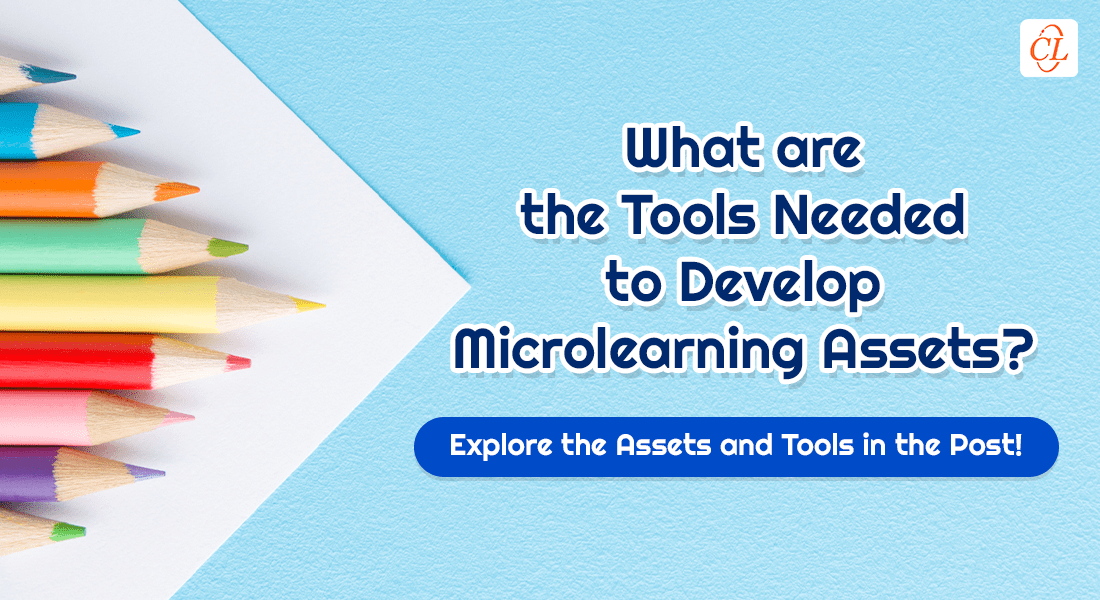Microlearning: An Effective Solution for Corporate Training

Along with the global COVID-19 pandemic, many other factors such as reducing attention spans, increasing distractions, dynamic work environments, and trying to keep up with today’s fast-paced world, are forcing us to rethink our approaches to training. As changing times pose a challenge to your corporate training initiatives, you must be looking for a quick and easy way to stay on top of things. And adding to our training woes is the fact that within about a month of learning something new, learners begin to forget almost 90% of the new information. The best way to fight this forgetting curve is by reinforcing the knowledge through repetition. How do we do that? The answer is simple – microlearning!
Explore eLearning Trends to keep up with changing learner preferences.
What is Microlearning?
Microlearning is learning that is delivered in bite-sized chunks, each module dealing with a single learning objective and short enough to deliver the information in one go. A learner should be able to complete the learning bite of information and achieve one learning objective within 10-15 minutes.
Types of Microlearning Assets
Microlearning can be used in many different formats depending on the learners’ requirements. The choice of microlearning assets that are used will depend on the target audience, the learning objective, and the type of content associated with the objective – whether they are Facts, Concepts, Principles, Procedures, Processes. The format of the microlearning asset should always be based on the function or the objective.
Example
The objective is to deliver a simple microlearning asset to new hires on available support (resources and teammates) that can be shared with the welcome email on their first day. What will work very well here is an animated GIF with a message that they are joining an amazing team with lots of support to welcome them and help them succeed!
How is Microlearning different from eLearning?
eLearning courses deal with multiple learning objectives and provide a comprehensive learning experience. On the other hand, microlearning focuses on delivering on-demand knowledge, with short bursts of content. Each microlearning module covers only one learning objective, making the learning very specific and focused.
Here’s Why You Should be Using Microlearning
Microlearning has multiple advantages for corporate training as it:
- Saves learner’s time
- Aids memory retention
- Creates higher learner engagement
- Offers flexibility with content and formats
- Is accessible on mobile devices
While it is difficult to remember everything that might be dealt with in an eLearning course (or even in classroom training), it is easier to remember and apply the short and specific information discussed in a microlearning asset. Microlearning can be used to complement eLearning or classroom training through refresher modules that help the learner revise and reassess what was covered in the primary training.
Advantages of Microlearning for Corporate Training
Saves time: Microlearning takes very little of the learner’s time due to their short duration. This means you can easily fit a microlearning module into a busy schedule with the learning available at the time of need.
Better retention: When information is delivered in short and focused units, it is easier to remember it. Studies have proven microlearning to more effective than regular classroom training in terms of transferring knowledge.
Higher learner engagement: Since microlearning modules are shorter and available in different formats, they have higher completion rates as learners are more likely to complete them in one sitting. This also helps foster a sense of accomplishment, helping the learner stay focused and motivated to learn more.
Flexibility: Microlearning modules are flexible, both in terms of content and access (any time the learner wishes). They can also be delivered in a variety of formats, making the entire learning experience really flexible. Microlearning can be used for any topic or subject, and can enable learning even in environments not conducive to learning, such as a busy factory floor, the waiting room in a doctor’s clinic, etc.
Accessibility: Since microlearning assets are easily available on mobile devices, they can be accessed anywhere on any mobile device – be it a smartphone or a tablet. The variety of choices available (audio, video, GIFs, quizzes, etc.), also makes microlearning highly appealing for learners.
How Microlearning Can Solve Corporate Training Problems
Even though we are used to eLearning courses dealing with multiple learning objectives, microlearning does pack a punch when it comes to its usefulness in training for corporates.
Where do smaller courses fit in? How will they help us bridge learning gaps?

Microlearning does this by:
Promoting a learning culture: When training assets are repurposed into microlearning assets and used regularly, they provide ample choices to learners to pick and learn in their preferred formats. Continuous opportunities to learn in this manner promote a learning culture.
Preparing learners for online or classroom training: Infographics, short videos, and GIFs are effective ways of introducing learners to a topic and providing information about the training that is to come. Micro quizzes can be used to assess learners’ existing knowledge and flashcards to recap information.
Offering performance support: Microlearning modules are easy to develop and update. This makes training fast and flexible. Their mobile compatibility, short size, and easy availability makes them perfect for delivering performance support (just-in-time training) for learners at their moment of need.
For instance, if a person working on a piece of equipment needs help with a single function, he or she does not have to wade through an entire eLearning course. Instead, they can simply access a microlearning module on that specific function and apply that knowledge in the workplace immediately.
Fighting the forgetting curve (as refresher training): We easily forget what we learned in training if we do not periodically revisit it. For successfully implementing spaced learning after training, microlearning assets can be pushed at regular intervals to learners to refresh their memory.
Revisiting an entire course to refresh the learning may not be feasible all the time and may be counter-productive by making the learner lose interest in the course. Microlearning modules, being short and focused, can be used to reinforce learning whenever required.
Bottom Line
We have discussed the various ways in which microlearning is useful in corporate training. That being said, there are a few situations in which microlearning may not be an appropriate mode of training, especially when we’re dealing with complex subjects or when the learner is new to the subject.
However, microlearning still is an efficient way to save developers’ time and cost, and increase learning and retention, as compared to traditional methods of training. It’s the best way to increase employee efficiency and confidence!
Interested to know more about microlearning and its various applications? Download this free book and get a detailed explanation on incorporating microlearning for macro performance enhancements!
Editor’s note: This post was originally published in January 2022 and has been updated for comprehensiveness.




![4 Ways to Create Microlearning for your Sales Training [Infographic]](https://blog.commlabindia.com/hubfs/Imported_Blog_Media/microlearning-for-sales-training-infographic.png)
